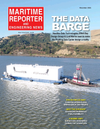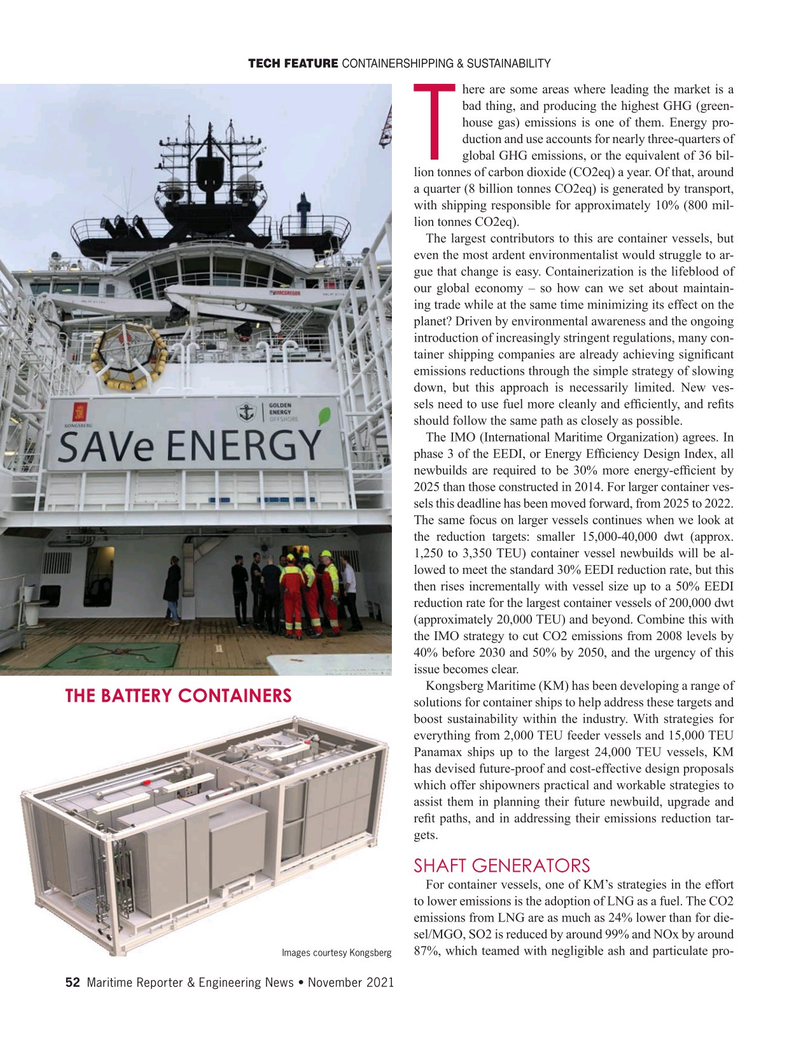
Page 52: of Maritime Reporter Magazine (November 2021)
The Workboat Edition
Read this page in Pdf, Flash or Html5 edition of November 2021 Maritime Reporter Magazine
TECH FEATURE CONTAINERSHIPPING & SUSTAINABILITY here are some areas where leading the market is a bad thing, and producing the highest GHG (green- house gas) emissions is one of them. Energy pro- duction and use accounts for nearly three-quarters of
T global GHG emissions, or the equivalent of 36 bil- lion tonnes of carbon dioxide (CO2eq) a year. Of that, around a quarter (8 billion tonnes CO2eq) is generated by transport, with shipping responsible for approximately 10% (800 mil- lion tonnes CO2eq).
The largest contributors to this are container vessels, but even the most ardent environmentalist would struggle to ar- gue that change is easy. Containerization is the lifeblood of our global economy – so how can we set about maintain- ing trade while at the same time minimizing its effect on the planet? Driven by environmental awareness and the ongoing introduction of increasingly stringent regulations, many con- tainer shipping companies are already achieving signi? cant emissions reductions through the simple strategy of slowing down, but this approach is necessarily limited. New ves- sels need to use fuel more cleanly and ef? ciently, and re? ts should follow the same path as closely as possible.
The IMO (International Maritime Organization) agrees. In phase 3 of the EEDI, or Energy Ef? ciency Design Index, all newbuilds are required to be 30% more energy-ef? cient by 2025 than those constructed in 2014. For larger container ves- sels this deadline has been moved forward, from 2025 to 2022.
The same focus on larger vessels continues when we look at the reduction targets: smaller 15,000-40,000 dwt (approx. 1,250 to 3,350 TEU) container vessel newbuilds will be al- lowed to meet the standard 30% EEDI reduction rate, but this then rises incrementally with vessel size up to a 50% EEDI reduction rate for the largest container vessels of 200,000 dwt (approximately 20,000 TEU) and beyond. Combine this with the IMO strategy to cut CO2 emissions from 2008 levels by 40% before 2030 and 50% by 2050, and the urgency of this issue becomes clear.
Kongsberg Maritime (KM) has been developing a range of
THE BATTERY CONTAINERS solutions for container ships to help address these targets and boost sustainability within the industry. With strategies for everything from 2,000 TEU feeder vessels and 15,000 TEU
Panamax ships up to the largest 24,000 TEU vessels, KM has devised future-proof and cost-effective design proposals which offer shipowners practical and workable strategies to assist them in planning their future newbuild, upgrade and re? t paths, and in addressing their emissions reduction tar- gets.
SHAFT GENERATORS
For container vessels, one of KM’s strategies in the effort to lower emissions is the adoption of LNG as a fuel. The CO2 emissions from LNG are as much as 24% lower than for die- sel/MGO, SO2 is reduced by around 99% and NOx by around 87%, which teamed with negligible ash and particulate pro-
Images courtesy Kongsberg 52 Maritime Reporter & Engineering News • November 2021
MR #11 (50-65).indd 52 11/4/2021 11:07:45 AM

 51
51

 53
53
